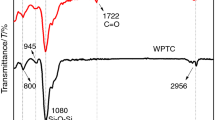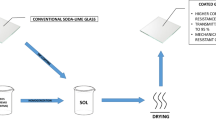Abstract
In this paper, a sol–gel method was adopted, using tetraethyl orthosilicate (TEOS) as a precursor, to prepare hollow silica spheres through alkali-catalyzed sol, and further to form a long-chain structure through acid catalysis. The alkali-aluminosilicate glass is coated with hollow silica spheres by a dip coating method, and the anti-reflection (AR) nanostructured silica coatings with different thicknesses and porosities are obtained. The prepared hollow silica spheres have an inner diameter of 20 nm and a wall thickness of 6–20 nm. The average transmittance of the coating at normal incidence within the wavelength range of 300–900 nm is between 94 and 96.9%, a great improvement compared with 91.8% of the substrate. Hollow spherical and long-chain structure of silica is conducive to film formation on the glass surface and endows the film with a high mechanical strength. After 60 friction cycles, the average transmittance is only decreased by 0.6%.
Graphical abstract











Similar content being viewed by others
References
A. Amri, Z.T. Jiang, N. Wyatt, C.Y. Yin, M.M. Rahman, Optical properties and thermal durability of copper cobalt oxide thin film coatings with integrated silica antireflection layer. Ceram. Int. 40, 16569–16575 (2014). https://doi.org/10.1016/j.ceramint.2014.08.012
Nakagawa, Kenichi, Liquid crystal projector, liquid crystal device and substrate for liquid crystal device: US, US7554635 B2. 2009.
R. Prado, G. Beobide, A. Marcaide, J. Goikoetxea, A. Aranzabe, Development of multifunctional sol–gel coatings: anti-reflection coatings with enhanced self-cleaning capacity. Energy Mater. Sol. Cells 94, 1081–1088 (2010). https://doi.org/10.1016/j.solmat.2010.02.031
M.C. Bautista, A. Morales, Silica antireflective films on glass produced by the sol–gel method. Sol. Energy Mater. Sol. Cells. 80, 217–225 (2003). https://doi.org/10.1016/j.solmat.2003.06.004
M. Chigane, Y. Hatanaka, T. Shinagawa, Enhanced antireflection properties of silica thin films via redox deposition and hot-water treatment. Sol. Energy Mater. Sol. Cells. 94, 1055–1058 (2010). https://doi.org/10.1016/j.solmat.2010.02.024
T. Muromachi, T. Tsujino, K. Kamitani, K. Maeda, Application of functional coatings by sol–gel method. J. Solgel Sci. Technol. 40, 267–272 (2006). https://doi.org/10.1007/s10971-006-8386-7
W. Stöber, A. Fink, E. Bohn, Controlled growth of monodisperse silica spheres in the micron size range. J. Colloid Interface Sci. 26, 62–69 (1968). https://doi.org/10.1016/0021-9797(68)90272-5
Z.Q. Guo, Y. Liu, M.Y. Tang, J.H. Wang, X.P. Su, Super-durable closed-surface antireflection thin film by silica nanocomposites. Colloid Interface Sci. 170, 143–148 (2017). https://doi.org/10.1016/j.solmat.2017.05.043
J.Q. Xi, J.K. Kim, E.F. Schubert, Silica nanorod-array films with very low refractive indices. Nano Lett. 5, 1385–1387 (2005). https://doi.org/10.1021/nl050698k
M. Vilarigues, R. Silva, Characterization of potash-glass corrosion in aqueous solution by ion beam and IR spectroscopy. J. Non Cryst. Solids. 352, 5368–5375 (2006). https://doi.org/10.1016/j.jnoncrysol.2006.08.032
I.M. Thomas, High laser damage threshold porous silica antireflective coating. Appl. Opt. 25, 148–1483 (1986). https://doi.org/10.1364/AO.25.001481
X. Zhang, P. Lan, Y. Lu, J. Li, H. Xu, J. Zhang, Y.P. Lee, J.Y. Rhee, K.L. Choy, W. Song, Multifunctional antireflection coatings based on novel hollow silica-silica nanocomposites. ACS Appl. Mater. Interfaces. 6, 1415–1423 (2014). https://doi.org/10.1021/am405258d
Z. Guo, H. Zhao, W. Zhao, T. Wang, T. Chen, X. Zhang, High-quality hollow closed-pore silica antireflection coatings based on styrene-acrylate Emulsion @ organic-inorganic silica precursor. ACS Appl. Mater. Interfaces. 8, 11796–11805 (2016). https://doi.org/10.1021/acsami.6b02192
C. Tao, H. Yan, X. Yuan, Q. Yin, J. Zhu, W. Ni, L. Yan, L. Zhang, Hydrophobic antireflective coatings with ultralow refractive index synthesized by deposition of methylated hollow silica nanoparticles. Mater. Lett. 183, 374–377 (2016). https://doi.org/10.1016/j.matlet.2016.07.042
P. Buskens, M. Burghoorn, M.C. Mourad, Z. Vroon, Antireflective coatings for glass and transparent polymers. Langmuir 32, 6781–6793 (2016). https://doi.org/10.1021/acs.langmuir.6b00428
M. Ogawa, Formation of novel oriented transparent films of layered silica-surfactant nanocomposites. J. Am. Chem. Soc. 116, 7941–7942 (1994). https://doi.org/10.1021/ja00096a079
F. Guillemot, A. Brunet-Bruneau, E. Bourgeat-Lami, T. Gacoin, E. Barthel, Latex-templated silica films: tailoring porosity to get a stable low-refractive index. Chem. Mater. 22, 2822–2828 (2010). https://doi.org/10.1021/cm903754k
Y. Mu, Ma. Jin, L. Cheng, Z.Z. Zhang, F. Yang, Y. Lu, General synthetic route toward functional hollow spheres with double-shelled structures. Angew. Chem. Int. Ed. 10, 6727–6730 (2005). https://doi.org/10.1002/ange.200501556
K.H. Nielsen, T. Kittel, K. Wondraczek, L. Wondraczek, Optical breathing of nano-porous antireflective coatings through adsorption and desorption of water. Sci. Rep. 4, 6595 (2014). https://doi.org/10.1038/srep06595
C. Wang, H. Gao, D. Liang, S. Liu, H. Zhang, H. Guan, Y. Wu, Y. Zhang, Effective fabrication of flexible nickel chains/acrylate composite pressure-sensitive adhesives with layered structure for tunable electromagnetic interference shielding. Adv. Compos. Hybrid. Mater. 5, 2906–2920 (2022). https://doi.org/10.1007/s42114-022-00482-7
Y. Wan, S.H. Yu, Polyelectrolyte controlled large-scale synthesis of hollow silica spheres with tunable sizes and wall thicknesses. J. Phys. Chem. c 112, 3641–3647 (2008). https://doi.org/10.1021/jp710990b
C.J. Carmalt, S. Sanjayan, I.P. Pakin, C.R. Crick, J.L. Song, L. Yao, Robust self-cleaning surfaces that function when exposed to either air or oil. Sci. Rep. 347, 1132–1135 (2015). https://doi.org/10.1126/science.aaa0946
J. Lin, Preparation of high surface property silica gel materials by sol–gel method. J. Build. Mater. 1, 155–159 (1998)
J. Lin, Effect of catalyst on the hydrolysis-polymerization mechanism of ethyl orthosilicate. J. Inorg. Mater. 12, 363–369 (1997)
C.J. Brinker, Hydrolysis and condensation of silicates: effects on structure. J. Non-Cryst. Solids 100, 31–50 (1998). https://doi.org/10.1016/0022-3093(88)90005-1
L.F. Wang, The optimum matching of single-layer-anti-reflective coatings with semiconductor solar cells. Acta Energiae Solaris Sinica. 10, 110–117 (1989). https://doi.org/10.19912/j.0254-0096.1989.01.014
Yoldas, Investigations of porous oxides as an antireflective coating for glass surfaces. B. E. Appl. Opt. 19, 1425–1429 (1980). https://doi.org/10.1364/AO.19.001425
K. Qingping, F. Wenqian, J. Huile, Z. Lei, T. Tiandi, Z. Jingfeng, Fabrication of mechanically robust superhydrophobic surfaces based on silica micro-nanoparticles and polydimethylsiloxane. Surf. Coat. Technol. 205, 4910–4914 (2011). https://doi.org/10.1016/j.surfcoat.2011.04.073
Acknowledgments
Not Applicable.
Author information
Authors and Affiliations
Corresponding author
Ethics declarations
Conflict of interest
The authors declare that they have no conflict of interest.
Additional information
Publisher's Note
Springer Nature remains neutral with regard to jurisdictional claims in published maps and institutional affiliations.
Supplementary Information
Below is the link to the electronic supplementary material.
Rights and permissions
Springer Nature or its licensor (e.g. a society or other partner) holds exclusive rights to this article under a publishing agreement with the author(s) or other rightsholder(s); author self-archiving of the accepted manuscript version of this article is solely governed by the terms of such publishing agreement and applicable law.
About this article
Cite this article
Han, Z., Yuan, J., Tian, P. et al. Preparation of highly transparent and wear-resistant SiO2 coating by alkali/acid dual catalyzed sol–gel method. Journal of Materials Research 38, 3316–3323 (2023). https://doi.org/10.1557/s43578-023-01062-1
Received:
Accepted:
Published:
Issue Date:
DOI: https://doi.org/10.1557/s43578-023-01062-1




